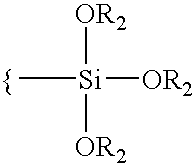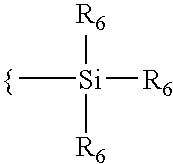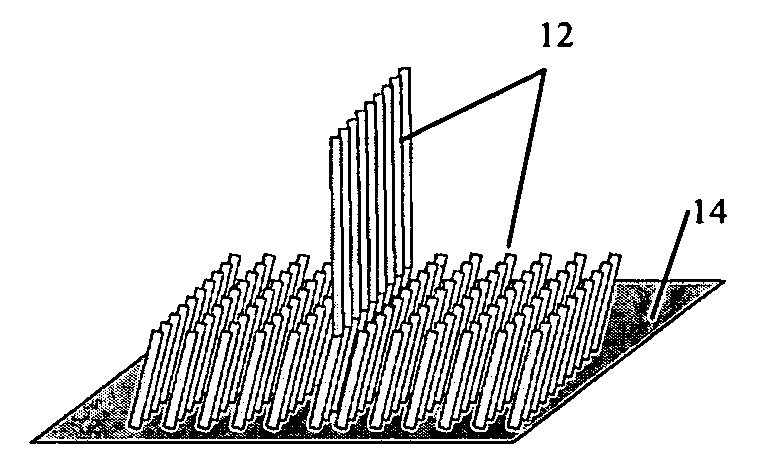Nanocontact printing
a technology of nano-contact printing and printing plate, which is applied in the field of nano-contact printing, can solve the problems of inability to scale up production, inability to meet the needs of customers, etc., and achieve the effect of constant production of masters
- Summary
- Abstract
- Description
- Claims
- Application Information
AI Technical Summary
Benefits of technology
Problems solved by technology
Method used
Image
Examples
example 1
Preparation of a Complement Image of a DNA Monolayer
[0100] A. Preparation of DNA Solutions
[0101] All glassware was cleaned with a solution of 75% H2SO4 and 25% H2O2 before use. All water used was ultrapure water (18MΩ / cm).
[0102] The primary DNA, 5′- / 5-ThiolMC6-D / ACG CAA CTT CGG GCT CTT-3′, were purchased from Integrated DNA Technologies, Inc. (IDT), Coraville, Iowa. All DNA strands were used as received from the manufaturer. The primary DNA was dissolved in water at the concentration of 1 μg / mL and divided into smaller aliquots of 50 μL, and stored at −20° C. When a portion of this solution was used, an aliquot was reduced by placing it in a 40 mM buffer solution (0.17 M sodium phosphate, pH 8) having dithiothreitol (DTT) for 16 hr. The oligonucleotides were separated from the by-products of the DTT reaction using size exclusion chromatography (NAP 10 column from Pharmacia Biotech) following the manufactures instructions. 10 mM sodium phosphate buffer (pH 6.8) was used to equilib...
example 2
Pattern Transfer of Gold Grid
[0111] An AFM calibration gold grid was dipped in 4 μM solution of the primary DNA molecules described in Example 1 for 5 days to generate a patterned master. The master was exposed to 1 mM 6-mercapto-1-hexanol aqueous solution for 2 hr to minimize nonspecific adsorption of single-stranded DNA, then rinsed with water 5 times and air-dried. The master was then exposed to a 6 μM solution of the secondary DNA described in Example 1 for 2 hours so that hybridization occurred. A second substrate of gold on mica was placed on the master so that the two gold surfaces were facing each other and had a small amount of water in between them. A small mechanical force was applied to force the two substrates together. After about 5 hr, the substrates were dipped into 1M NaCl in TE buffer solution (70° C.) for 20 min. The two substrates (i.e., master and the complement image) spontaneously separated and were rinsed with 1M NaCl in TE buffer 2 times and with water 5 ti...
example 3
[0112] A master is prepared using Dip Pen Nanolithography, as described in Demer, et al., Angew. Chem. Int. Ed. (2001), 40:30713073, the entire teachings of which are incorporated herein by reference. To prepare the master, a surface of a gold on mica substrate is contacted with a 1 mM solution of 1-octadecanethiol (ODT) in ethanol for 5 min. to cover the exposed gold surface with ODT molecules. The substrate is then immersed in a 1 mM solution of 1,16-mercaptohexadecanoic acid (MHA) and the tip of an atomic force microscope is used to displace ODT molecules bound to the surface by contacting the surface with a force of about 0.5 nN making a 100 nm dot. The MHA in solution binds to the exposed gold surface of the dot. The carboxylic acid groups of the MHA are activated with a 10 mg / mL solution of 1-ethyl-3-(3-dimethylaminoproppyl)carbodiimide hydrochloride (EDAC) in 0.1M morpholine / ethanesulfonic acid at pH 4.5, and then rinsed with a solution of 0.1M sodiu...
PUM
| Property | Measurement | Unit |
|---|---|---|
| area | aaaaa | aaaaa |
| dissociation constant | aaaaa | aaaaa |
| concentration | aaaaa | aaaaa |
Abstract
Description
Claims
Application Information
 Login to View More
Login to View More - R&D
- Intellectual Property
- Life Sciences
- Materials
- Tech Scout
- Unparalleled Data Quality
- Higher Quality Content
- 60% Fewer Hallucinations
Browse by: Latest US Patents, China's latest patents, Technical Efficacy Thesaurus, Application Domain, Technology Topic, Popular Technical Reports.
© 2025 PatSnap. All rights reserved.Legal|Privacy policy|Modern Slavery Act Transparency Statement|Sitemap|About US| Contact US: help@patsnap.com



